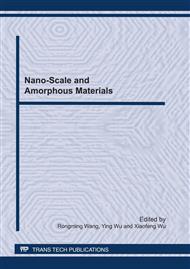p.90
p.95
p.102
p.107
p.116
p.122
p.127
p.135
p.141
Flame Synthesis of Carbon Nanotubes and Nanocapsules
Abstract:
Flame synthesis of carbon nanotubes and nanocapsules is demonstrated via a pyramid-shaped pyrolysis flame. The mixture of CO, H2, and nebulized catalyst raw material reacts in a high temperature environment formed inside the frustum of pyramid-shaped reactor heated by premixed flame of C2H2 and air outside. A sampling substrate inserted into the incomplete combusting flame of central reacting mixtures can gain the samples of carbon nanotubes and nanocapsules. The effect of sampling time and catalyst concentration is revealed via Field emission scanning electron microscope (FE-SEM) and High-resolution transmission electron microscopy (HR-TEM). 5-mins sampling time and 0.5/50 (Fe(CO)5/C2H5OH, volume ratio) of catalyst concentration is the most appropriate for carbon nanotubes synthesis. In addition, it is to say that catalyst concentration is the most important one among all the factors that can be used to determine whether the main products are carbon nanotubes or nanocapsules, and the structures of nanocapsules are also analyzed in detail.
Info:
Periodical:
Pages:
116-121
Citation:
Online since:
June 2011
Authors:
Price:
Сopyright:
© 2011 Trans Tech Publications Ltd. All Rights Reserved
Share:
Citation:


